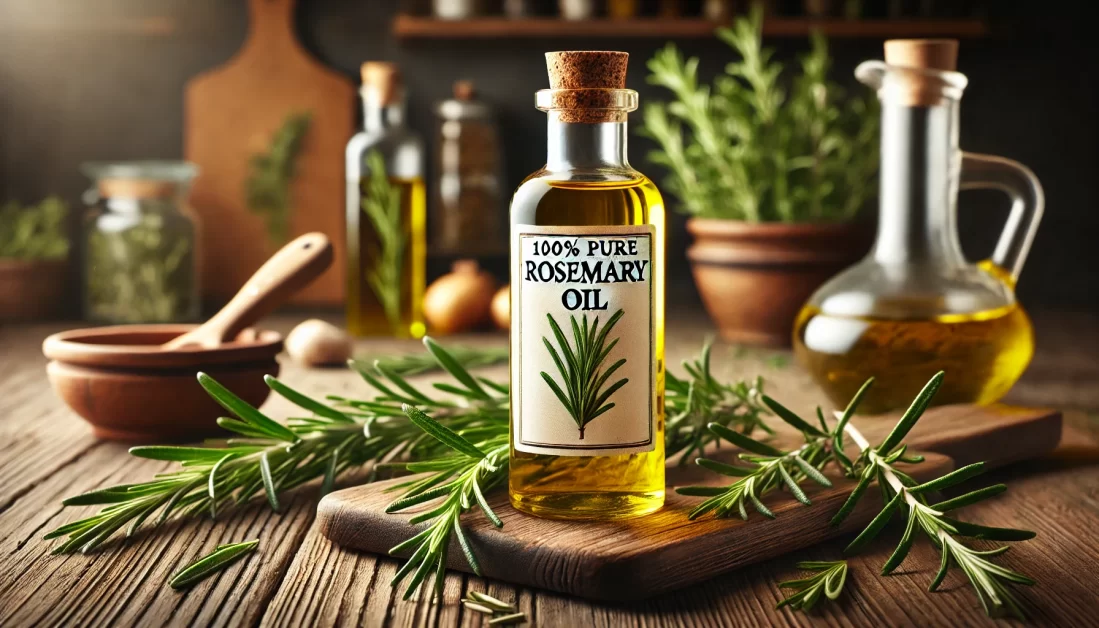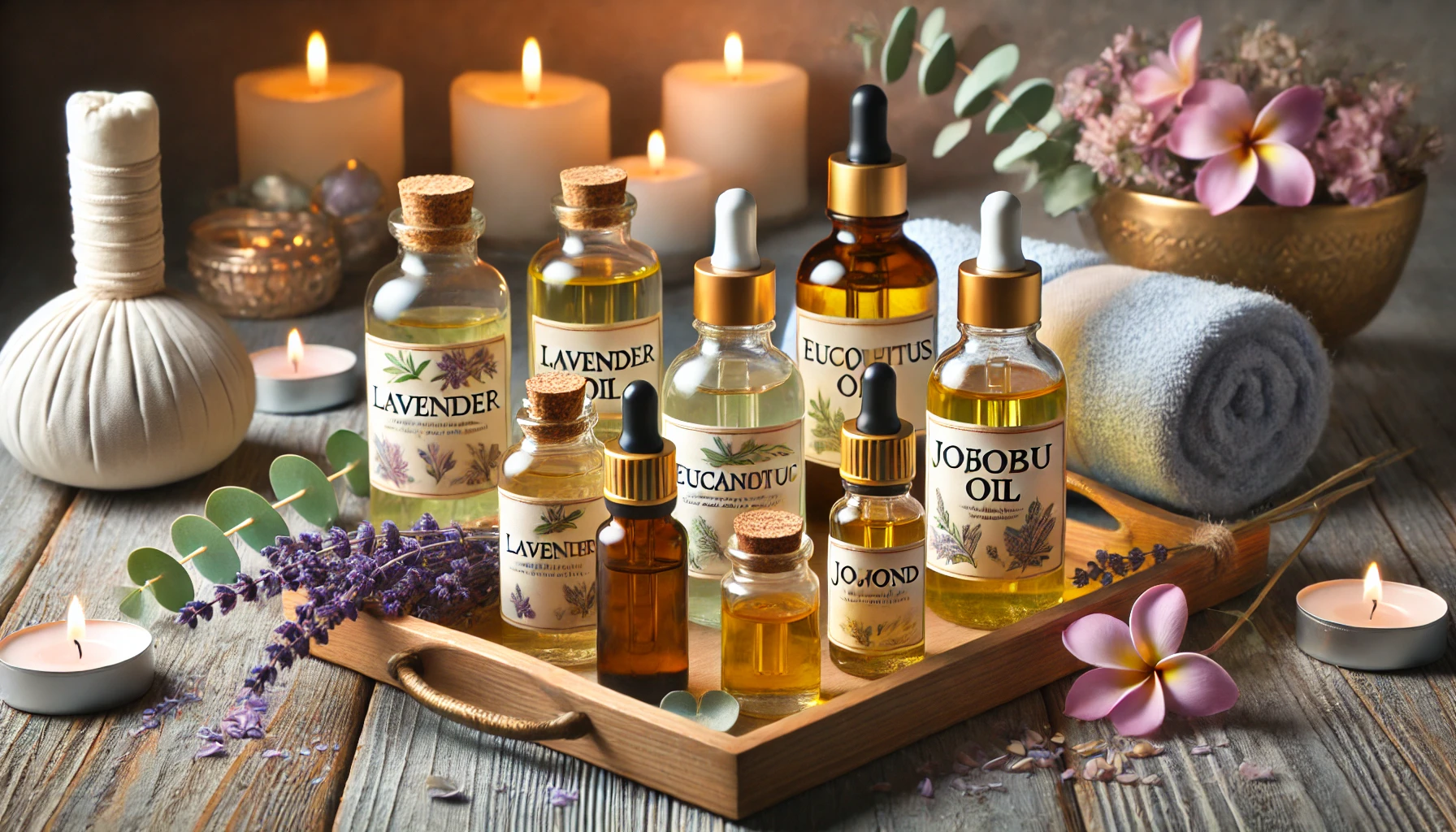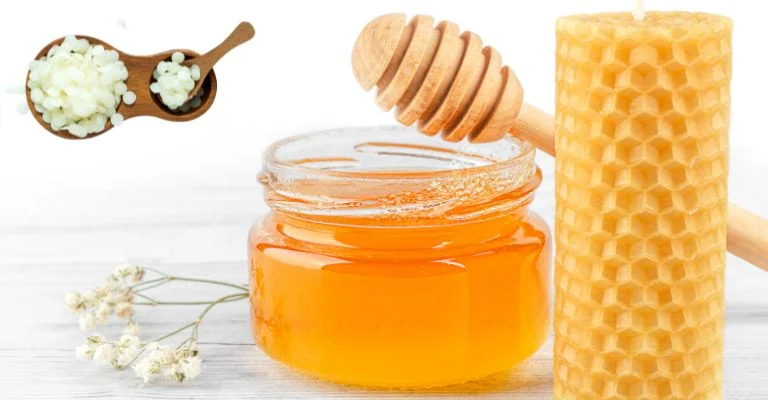Massage Oil Ingredients: Safe, Natural Solutions for Pain Relief and Relaxation
Finding the right ingredients for massage oil can feel overwhelming, especially when you want something natural, effective, and safe for your skin.
Whether you’re looking to create a soothing blend for relaxation, relieve muscle pain, or craft a special oil for couples, the process shouldn’t be complicated. If you’re worried about allergies, unsure which base oils to use, or need guidance on mixing herbs and essential oils, you’re not alone.
We’ll walk you through easy, homemade recipes and ingredient tips so you can confidently make massage oils tailored to your needs.
Quick Overview
If your goal is to relieve pain, reduce stress, or enhance intimacy then Choose carrier oils, such as coconut or almond oil, for their hydrating and soothing properties, and combine them with essential oils like lavender for relaxation or peppermint for invigoration.
For a safe, natural experience, avoid harmful additives such as artificial fragrances, mineral oil, or parabens that can irritate the skin or pose long-term health risks.
Feel free to experiment with essential oils until you find the blend that suits you best. Whether you’re preparing for a soothing self-care routine or a romantic evening, customizing your massage oil ensures an experience that’s both therapeutic and enjoyable.
Table of Massage Oil Ingredients and Their Uses
| Category | Options | Properties | Best For |
|---|---|---|---|
| Carrier Oils | Coconut Oil (Fractionated / Virgin) | Lightweight, hydrating, antimicrobial | Dry skin, general massage |
| Olive Oil | Rich in antioxidants, deeply moisturizing | Dry, mature skin, deep tissue massage | |
| Sweet Almond Oil | Soothing, high in vitamin E, non-comedogenic | Sensitive, dry skin | |
| Grapeseed Oil | Light, non-greasy, rich in antioxidants | Oily or acne-prone skin, smooth glide | |
| Jojoba Oil | Mimics natural sebum, absorbs easily | All skin types, including oily skin | |
| Sunflower Oil | High in vitamin E, supports skin barrier | Sensitive, dry skin【30†source】 | |
| Essential Oils | Lavender Oil | Calming, reduces anxiety, promotes healing | Relaxation, sensitive skin |
| Peppermint Oil | Cooling, reduces muscle pain, improves circulation | Muscle relief, sports massage | |
| Eucalyptus Oil | Decongestant, anti-inflammatory | Respiratory health, muscle pain | |
| Tea Tree Oil | Antiseptic, antifungal, reduces breakouts | Oily or acne-prone skin, healing | |
| Chamomile Oil | Soothing, reduces irritation and redness | Relaxation, sensitive skin | |
| Rosemary Oil | Stimulating, enhances circulation and focus | Muscle stiffness, energy boost | |
| Herbal Infusions | Arnica Oil | Anti-inflammatory, reduces swelling | Muscle recovery, chronic pain relief |
| Calendula Oil | Soothes and restores irritated skin | Sensitive or inflamed skin | |
| Additives | Vitamin E | Extends shelf life, hydrates skin | All skin types, enhances other oils |
The Basics of Massage Oil Ingredients
Understanding Key Ingredients
1. Carrier Oils:
- Coconut Oil: Known for its deep moisturizing properties, coconut oil is lightweight and provides an excellent glide during massages. Fractionated coconut oil, which stays liquid at all times, is preferred for ease of use.
- Olive Oil: Rich in antioxidants and vitamins, olive oil is thicker, offering deep skin hydration, making it ideal for dry or mature skin.
- Almond Oil: A favorite among massage therapists, almond oil has a light texture, a mild nutty scent, and nourishes the skin without leaving a heavy residue.
- Jojoba Oil: Technically a liquid wax, jojoba oil mimics the skin’s natural oils, making it suitable for sensitive or acne-prone skin. It absorbs easily and leaves a non-greasy finish.
2. Essential Oils:
- Lavender: Known for relaxation, lavender oil helps reduce stress and anxiety.
- Peppermint: Offers a cooling sensation, making it effective for muscle pain relief.
- Eucalyptus: Helps with respiratory issues and provides an invigorating massage experience.
- Rosemary: Commonly used for enhancing circulation and reducing inflammation.
3. Herbal Infusions and Additives:
- Herbal oils like calendula-infused oil offer anti-inflammatory benefits for sensitive skin.
- Additives such as vitamin E enhance the oil’s moisturizing properties while extending its shelf life.
Benefits and Considerations of Massage Oil Ingredients
Combination of ingredients is key foundation to create massage oils for pain relief, relaxation, or skin nourishment. Using high-quality carrier oils ensures the essential oils are effectively absorbed without irritation.
- Skin Nourishment and Hydration: Carrier oils, like almond and olive oil, provide essential fatty acids and vitamins that soften and moisturize the skin.
- Muscle Relaxation and Pain Relief: Oils infused with peppermint or arnica help relieve muscle tension and pain.
- Improved Circulation and Stress Reduction: Essential oils, such as lavender and rosemary, stimulate blood flow and promote relaxation, reducing stress levels.
- Safety Tips: It’s essential to test oils on a small patch of skin, particularly if you have allergies or sensitive skin. Nut-based oils (e.g., almond) should be avoided by individuals with nut allergies to prevent adverse reactions.
Sources: Psych Times, Base Formula, VedaOils USA, Loving Essential Oils.
Scientific Support for Massage Oil Ingredients
Together, the combination of scientifically-backed essential oils, carrier oils, and herbal infusions offers a well-rounded approach to massage therapy, promoting pain relief, relaxation, and skin health.
Studies on Essential Oils for Pain Relief and Stress Management
Research shows that essential oils, such as lavender, peppermint, and eucalyptus, play a significant role in reducing pain and stress. Lavender, in particular, is widely studied for its anxiolytic (anti-anxiety) and sedative properties. A study found that massage with lavender oil reduced muscle pain and improved sleep quality in participants suffering from chronic pain.
Peppermint oil, known for its menthol content, provides a cooling sensation, alleviating muscle soreness and tension. Additionally, eucalyptus oil has been shown to enhance respiratory function, which indirectly promotes relaxation by easing breathing during stress.
Carrier Oils and Their Moisturizing Properties
Carrier oils like almond, jojoba, and coconut oil offer more than just lubrication during massage—they deliver essential fatty acids and vitamins that nourish the skin. Jojoba oil, closely resembling natural sebum, helps regulate moisture and protect sensitive skin from irritation.
Almond oil is recognized for its long-lasting moisturization and mild aroma, making it ideal for massages that require extended application.
Coconut oil, especially in its fractionated form, is a lightweight and easily absorbed oil. Studies suggest that it not only hydrates but also has antimicrobial properties, which further support skin health during frequent use in massages.
Herbal Extracts: Potential Anti-Inflammatory Effects
Herbal extracts, such as arnica and calendula, have gained attention for their anti-inflammatory properties. Arnica-infused oil is often used for muscle recovery and bruises, showing promising effects in reducing pain and swelling.
Similarly, calendula oil provides soothing relief for irritated or dry skin due to its anti-inflammatory compounds. These oils enhance the therapeutic effects of massage by combining herbal benefits with relaxation techniques.
Ingredients to Avoid in Massage Oils
By avoiding these problematic ingredients, you can ensure that your massage oils remain safe, effective, and suitable for a variety of skin types.
Artificial Fragrances and Colors
Artificial fragrances and synthetic dyes are often added to enhance the scent and appearance of massage oils. However, these ingredients can trigger skin irritation, allergies, and even respiratory issues in sensitive individuals. Many of these chemicals contain phthalates, which may also have endocrine-disrupting effects when absorbed through the skin.
Mineral Oil
Mineral oil is a petroleum-based ingredient that creates a barrier on the skin. While this may temporarily lock in moisture, it is non-comedogenic, meaning it clogs pores and prevents the skin from breathing. Over time, mineral oil can cause breakouts and hinder the skin’s natural renewal process, making it unsuitable for regular massage use.
Parabens and Propylene Glycol
Parabens are commonly used as preservatives, while propylene glycol acts as a humectant to retain moisture. Both ingredients have been linked to potential health risks with long-term exposure. Studies indicate that parabens can mimic estrogen, raising concerns about hormonal imbalances, while propylene glycol may lead to dermatitis and skin irritation in some users.
Allergenic Essential Oils
While essential oils offer numerous benefits, certain oils are more likely to cause allergic reactions. Tea tree oil, citrus oils (like lemon and orange), and clove oil are common allergens. They can trigger skin irritation or contact dermatitis, particularly when used in high concentrations or without proper dilution. Individuals with sensitive skin or known allergies should test essential oils on a small area before full application.
How to Make Massage Oil: DIY Recipes for Every Occasion
These recipes with set of options, from unscented oils for sensitive users to customized blends for relaxation, energy, and pain relief, ensuring there is something for every occasion.
Unscented Massage Oil Recipe
- Best Carrier Oils for Unscented Options:
- Fractionated Coconut Oil: Lightweight, non-greasy, and odorless, making it an ideal base oil for sensitive skin.
- Jojoba Oil: Known for mimicking the skin’s natural oils, it absorbs quickly and works well without additional scents.
- Grapeseed Oil: Light and quickly absorbed, perfect for those seeking a simple, fragrance-free massage experience.
- Ideal for Sensitive Skin or Fragrance-Free Environments: Unscented oils are gentle and reduce the risk of allergies or irritation, especially in therapeutic or clinical settings where fragrance sensitivity is a concern.
DIY Massage Oil with Essential Oils
- Relaxing Blend with Lavender and Chamomile:
- Combine 2 drops each of lavender and chamomile essential oils with 1 tablespoon of almond oil for a calming, sleep-inducing massage blend.
- Energizing Mix with Peppermint and Eucalyptus:
- Mix 3 drops peppermint oil, 2 drops eucalyptus oil, and 1 tablespoon grapeseed oil to create an invigorating massage oil perfect for muscle soreness or fatigue.
- Pain Relief Oil with Arnica and Clove Oil:
- Blend 5 drops of arnica oil with 3 drops clove essential oil in 2 tablespoons of olive oil. This mixture helps soothe muscle tension and reduce inflammation after physical activity.
Dreamy Hemp Blend for Sleep
- Recipe for Relaxation and Deep Sleep:
- Use 1 tablespoon of fractionated coconut oil as a base, adding 4 drops of hemp essential oil and 2 drops of lavender. Massage this oil onto the neck and temples before bedtime to enhance relaxation and promote restful sleep.
- Benefits of Hemp Essential Oil in Massage:
- Hemp oil offers anti-anxiety and calming effects, making it beneficial for improving sleep quality and reducing stress. It also hydrates the skin without clogging pores, making it a great addition to nighttime massage routines.
DIY Massage Oil Recipes for Different Uses
These recipes and ideas will help you create a DIY massage oils perfect for every occasion, from romantic evenings to self-care routines.
Romantic Natural Massage Oil Recipe for Couples
- Key Ingredients for Enhancing Intimacy:
- Ylang Ylang Essential Oil: Known for its aphrodisiac qualities, it helps create a calming and romantic atmosphere.
- Sandalwood Oil: Provides a warm, woody scent that promotes relaxation and connection.
- Jojoba Oil or Sweet Almond Oil: These oils are non-greasy and easily absorbed, ensuring smooth application during intimate massages.
- How to Create a Sensual Oil Blend:
- Mix 5 drops of ylang-ylang oil, 3 drops of sandalwood oil, and 2 tablespoons of sweet almond oil. Warm the blend slightly before use to enhance the sensory experience. This oil can help strengthen emotional bonding while nourishing the skin.
How to Make DIY Homemade Massage Oil
- Ingredients and Preparation Tips:
- Use a base of fractionated coconut oil (2 tablespoons) for a light, non-greasy feel. Add your choice of essential oils, such as peppermint for cooling relief or lavender for relaxation.
- Mix well and store in a glass bottle to preserve the oils. For added nourishment, include a few drops of vitamin E.
- Customizing Oils for Hands, Feet, or Full-Body Massage:
- For hand and foot massages, opt for a thicker carrier oil like olive oil, combined with rosemary or eucalyptus for a soothing effect.
- For full-body massages, lighter oils like grapeseed or sweet almond ensure easy absorption without leaving a greasy residue.
Transforming Your Massage Oil into a Spa Gift Basket
- Creative Packaging Ideas:
- Use small glass bottles with cork stoppers and label them with handwritten tags. Include dried flowers (like lavender or rose petals) inside the bottles for an elegant look.
- Pairing Oils with Candles and Lotions for a Complete Experience:
- Create a themed spa basket by adding scented candles, luxurious lotions, and a soft towel or eye mask. Combine your homemade massage oil with complementary items such as bath salts or aromatic sachets to elevate the gift’s appeal.
Best Carrier Oils for Massage and Their Benefits
The carrier oils not only enhance massage techniques by providing smooth glide but also offer additional therapeutic benefits, such as hydration and skin protection, making them versatile choices for various massage needs.
Coconut Oil: Lightweight and Hydrating
Fractionated coconut oil is a popular choice for massage due to its light texture and non-greasy feel. It absorbs quickly into the skin, providing deep hydration without clogging pores. Additionally, it has antimicrobial properties, making it ideal for frequent use in massages.
Olive Oil: Rich in Antioxidants and Vitamins
Olive oil is a thicker carrier oil known for its antioxidant-rich profile. It contains vitamins A, D, E, and K, which nourish the skin, making it especially effective for dry or aging skin. Its thicker consistency makes it suitable for targeted deep-tissue massage sessions, though it may leave a slight residue.
Almond Oil: Soothing for Sensitive Skin
Sweet almond oil is a go-to for many massage therapists due to its mild aroma and soothing properties. It provides long-lasting lubrication, making it perfect for extended massages. Rich in vitamin E, it’s ideal for sensitive skin and helps reduce inflammation, but it should be avoided by individuals with nut allergies.
Jojoba Oil: Closest to the Skin’s Natural Oils
Jojoba oil, technically a liquid wax, mimics the natural sebum of the skin, making it highly compatible with all skin types, including oily or acne-prone skin. Its non-comedogenic nature ensures it won’t clog pores, and it moisturizes deeply without leaving a greasy residue, making it ideal for both facial and full-body massages.
Types of Massage Oils
There are various types of massage oils, each with unique characteristics and benefits:
Carrier Oils
Carrier oils are base oils that dilute essential oils and help carry them into the skin. Common carrier oils include:
- Sweet Almond Oil: Light, easily absorbed, and suitable for all skin types.
- Jojoba Oil: Closely resembles skin’s natural sebum, making it highly compatible with all skin types.
- Coconut Oil: Known for its deep moisturizing properties and pleasant scent.
- Grapeseed Oil: Light and non-greasy, perfect for those with oily skin.
- Olive Oil: Rich in nutrients, ideal for dry skin, but may be too heavy for some.
- Sunflower Oil: High in Vitamin E, beneficial for skin healing and hydration.
Essential Oils
Essential oils are concentrated plant extracts known for their potent therapeutic properties. Popular oils include:
- Lavender Oil: Calming and relaxing, ideal for stress relief.
- Peppermint Oil: Provides a cooling sensation, great for muscle relief.
- Eucalyptus Oil: Helps with respiratory issues and has anti-inflammatory properties.
- Tea Tree Oil: Known for its antiseptic and antifungal properties.
- Chamomile Oil: Soothing and gentle, suitable for sensitive skin.
- Rosemary Oil: Stimulating and invigorating, improves circulation.

Carrier Oils in Massage Oils
Carrier oils are the foundation of most massage oil blends. They dilute essential oils and help them spread evenly over the skin, enhancing absorption while providing their own unique benefits. Here, we explore some of massage therapy’s most popular carrier oils.
Sweet Almond Oil
A popular choice in massage therapy that a light texture and high vitamin E content, and provides excellent moisturizing benefits. It helps to soothe and soften the skin, making it ideal for individuals with dry or sensitive skin, while also reducing irritation and inflammation.
Compatible with all skin types, and also beneficial for dry, irritated, or sensitive skin. Being non-comedogenic, it won’t clog pores, making it suitable even for those prone to acne or breakouts.
Jojoba Oil
Rich in vitamins E and B, along with minerals like zinc and copper, jojoba oil provides essential nourishment and protection for the skin. This is a technically wax ester, closely mimicking the skin’s natural sebum, absorb easily without leaving a greasy residue.
All skin types compatibility , including oily or acne-prone skin, due to its ability to balance the skin’s natural oils. Its non-greasy texture and deep moisturizing properties make it ideal for use in massage therapy, particularly in dry climates where hydration is essential.
Coconut Oil
Comes with in two forms:
- fractionated: Fractionated coconut oil, processed to remove long-chain fatty acids, remains liquid at room temperature, making it stable and easy to use for massages.
- Virgin: Virgin coconut oil, in contrast, is unrefined, retaining its natural aroma and solidifying at cooler temperatures, offering more beneficial compounds like antioxidants.
Both have deep moisturizing benefits, ideal for dry or damaged skin, with added antimicrobial properties that support skin health. Fractionated coconut oil is lightweight and non-greasy, spreading easily and absorbing quickly, perfect for therapeutic or full-body massages.
Grapeseed Oil
Lightweight, non-greasy oil that absorbs quickly, leaving the skin soft without residue. Its smooth glide makes it a preferred choice for massage therapy, ensuring seamless application. Packed with vitamins C and E, it offers powerful antioxidant properties, protecting the skin from free radical damage. The presence of linoleic acid supports skin health by improving elasticity and hydration.
Olive Oil
Rich in vitamins A, D, E, and K, provides deep hydration, making it ideal for dry and mature skin. Its thicker consistency offers excellent glide for deep tissue and sports massages, where slower movements are needed. Its heavy nature may not suit oily or acne-prone skin, as it can feel too dense and potentially clog pores.

Sunflower Oil
It rich in vitamin E, an antioxidant that shields the skin from environmental damage, and its light texture makes it ideal for massage. Thanks to its high linoleic acid content, it strengthens the skin’s natural barrier, promoting moisture retention and healing, which is especially beneficial for dry, sensitive, or mature skin
Check out 7 Reasons Why Your Massage Oil Can Expire Before Using It.
Essential Oils in Massage Oils

Essential oils are concentrated plant extracts that offer a range of therapeutic benefits. They enhance the massage experience through aromatherapy and their various healing properties when added to carrier oils. Below are some of the most popular essential oils used in massage therapy.
Lavender Oil
Known for its calming effects, it reduces stress and anxiety, promoting relaxation and emotional well-being—perfect for stress-relief massages. It also soothes skin irritation, reduces redness, and aids in the healing of minor cuts and burns, making it ideal for sensitive or damaged skin.
Peppermint Oil
With a refreshing cooling effect, it invigorates the senses while easing muscle tension and pain. The high menthol content helps reduce inflammation and improves blood flow, making it an excellent choice for sports massages and post-exercise recovery
Eucalyptus Oil
Known for its decongestant properties, it helps clear nasal passages and ease breathing, making it beneficial for massages focused on respiratory health. It also offers anti-inflammatory effects, reducing muscle pain and swelling, which makes it ideal for chronic pain relief and inflammation-focused massage therapy.
Tea Tree Oil
With antiseptic and antifungal properties, it effectively cleanses the skin and helps prevent infections, making it ideal for therapeutic massages focused on skin health. Its ability to reduce excess oil makes it particularly beneficial for acne-prone or oily skin, promoting clearer and healthier skin by preventing breakouts.
Chamomile Oil
With soothing and calming effects, it reduces stress and anxiety, making it perfect for relaxation massages. Gentle and suitable for sensitive skin, it helps alleviate redness and irritation, offering a calming effect for those with reactive or delicate skin.

Rosemary Oil
With stimulating and invigorating effects, it boosts circulation and enhances mental clarity, making it ideal for massages aimed at increasing energy and focus. Its circulatory benefits help reduce muscle stiffness and tension, improving blood flow and promoting overall relaxation during therapeutic massages
Check out My Self-Care Routine: Massage Oils Bath and Body Works.
Choosing the Right Massage Oil
Selecting the appropriate massage oil is crucial for maximizing the benefits of a massage. The choice depends on various factors, including skin type, desired effects, allergies, and personal preferences.
Skin Type Considerations
Dry Skin:
- Heavier oils like olive oil and coconut oil provide deep moisturizing.
- Prevents dryness and flakiness by nourishing and hydrating the skin.
Oily Skin:
- Lighter oils such as grapeseed oil and jojoba oil are recommended.
- These oils are non-comedogenic, balancing natural oil production without clogging pores.
Sensitive Skin:
- Gentle oils like chamomile oil and sweet almond oil help reduce irritation.
- These oils provide a soothing and calming effect on delicate skin.
Desired Effects and Benefits
Relaxation:
- Oils like lavender and chamomile reduce stress and promote tranquility.
- Ideal for relaxation-focused massages.
Muscle Relief:
- Peppermint and eucalyptus oils relieve muscle pain and tension with cooling, anti-inflammatory effects.
- Useful for sports and recovery massages.
Skin Healing:
- Tea tree oil and lavender oil offer antiseptic and skin-healing properties.
- Promote repair and faster healing of minor cuts and acne-prone skin.
Allergies and Sensitivities
Calming scents: Lavender and chamomile provide a relaxing experience.
Invigorating scents: Citrus oils like lemon and orange boost energy and uplift the mood.
Personal preference: Choosing a pleasant aroma enhances the massage experience.
Preferred Scents and Aromas
Personal preference plays a significant role in selecting massage oils. The scent of the oil can enhance the overall massage experience. Floral scents like lavender and chamomile are calming, while citrus scents like lemon and orange are invigorating. Choosing a scent that the individual finds pleasant can significantly enhance relaxation and enjoyment.
Massage Oils for Different Skin Types and Effects
| Skin Type / Effect | Recommended Oils | Benefits |
|---|---|---|
| Dry Skin | Olive oil, Coconut oil | Deep hydration, prevents flakiness |
| Oily/Acne-Prone Skin | Grapeseed oil, Jojoba oil | Balances oil production, won’t clog pores |
| Sensitive Skin | Chamomile oil, Sweet Almond oil | Soothes irritation, calms the skin |
| Relaxation | Lavender oil, Chamomile oil | Reduces stress, promotes tranquility |
| Muscle Relief | Peppermint oil, Eucalyptus oil | Relieves tension, improves circulation |
| Skin Healing | Tea Tree oil, Lavender oil | Antiseptic properties, supports skin repair |
Check out Does Massage Oil Expire? Consider These 7 Factors Carefully.
Popular Massage Oil Blends and Their Uses
Creating massage oil blends tailored to specific needs can greatly enhance the experience. Below are some popular massage oil blends and their uses, each designed to address different therapeutic goals.
Relaxation Blend
Ingredients and Benefits
- Carrier Oil: Sweet almond oil (100 ml)
- Essential Oils:
- Lavender oil (10 drops)
- Chamomile oil (5 drops)
- Ylang-ylang oil (5 drops)
Benefits
This blend is designed to promote deep relaxation and reduce stress. Lavender and chamomile oils are well-known for their calming properties, while ylang-ylang oil adds a sweet, floral aroma that enhances the soothing effect. Use this blend for evening massages to help unwind and prepare for restful sleep.
Energizing Blend
Ingredients and Benefits
- Carrier Oil: Grapeseed oil (100 ml)
- Essential Oils:
- Peppermint oil (8 drops)
- Lemon oil (6 drops)
- Rosemary oil (6 drops)
Benefits
An energizing blend is perfect for morning massages or a mid-day pick-me-up. Peppermint oil provides a refreshing, cooling sensation, while lemon and rosemary oils uplift the mood and boost mental clarity. This blend helps to invigorate the senses and promote alertness.
Muscle Relief Blend
Ingredients and Benefits
- Carrier Oil: Fractionated coconut oil (100 ml)
- Essential Oils:
- Eucalyptus oil (8 drops)
- Peppermint oil (8 drops)
- Marjoram oil (4 drops)
Benefits
This blend is formulated to alleviate muscle pain and tension. Eucalyptus and peppermint oils have cooling and anti-inflammatory properties that soothe sore muscles, while marjoram oil helps to relax muscle spasms and improve circulation. It is ideal for post-workout massages or to relieve chronic muscle discomfort.
Skin Healing Blend
Ingredients and Benefits
- Carrier Oil: Jojoba oil (100 ml)
- Essential Oils:
- Tea tree oil (6 drops)
- Lavender oil (6 drops)
- Frankincense oil (4 drops)
Benefits
A blend aimed at promoting skin health and healing. Tea tree oil has powerful antiseptic and antifungal properties, lavender oil soothes and repairs the skin, and frankincense oil promotes cellular regeneration and reduces the appearance of scars. Use this blend for massages focused on healing and improving skin condition.
Stress Relief Blend
Ingredients and Benefits
- Carrier Oil: Olive oil (100 ml)
- Essential Oils:
- Bergamot oil (8 drops)
- Clary sage oil (6 drops)
- Sandalwood oil (6 drops)
Benefits
Designed to alleviate stress and anxiety, this blend combines the uplifting scent of bergamot, the balancing effects of clary sage, and the grounding aroma of sandalwood. This combination helps to create a calming and serene atmosphere, perfect for stress-relief massages.
Detoxifying Blend
Ingredients and Benefits
- Carrier Oil: Sunflower oil (100 ml)
- Essential Oils:
- Juniper berry oil (8 drops)
- Grapefruit oil (6 drops)
- Fennel oil (6 drops)
Benefits
A detoxifying blend that aids in flushing out toxins and improving lymphatic drainage. Juniper berry oil is known for its detoxifying properties, grapefruit oil boosts circulation, and fennel oil supports the body’s natural detox processes. It is ideal for massages aimed at detoxification and revitalization.












